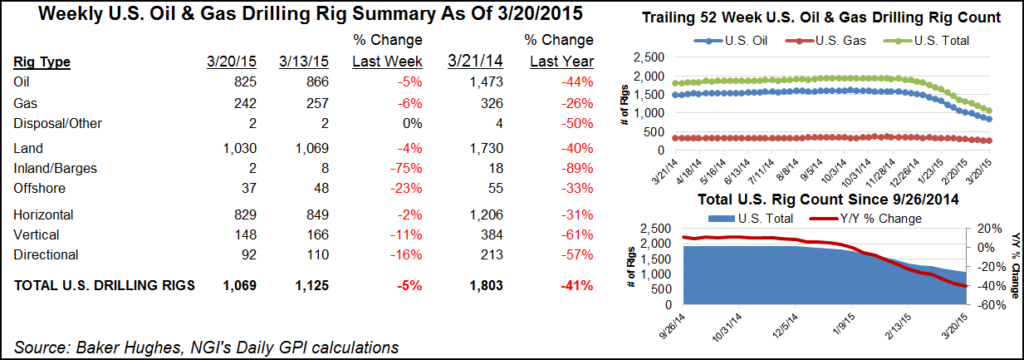17 NatGas Rigs Leave Active Duty; Oil Gains 17
Drillers voted overwhelmingly in favor of oil in the latest Baker Hughes Inc. U.S. rig count. While the overall U.S. count was static, 17 oil rigs were added, neatly offset by the departure of 17 natural gas rigs.

After plummeting 28 rigs in the week-ago tally, the census of active U.S. drilling rigs held steady with the previous week in the report issued Friday (Dec. 18).
No rigs departed U.S. land operations, according to the count; however, one rig exited the inland waters and one was added in the offshore. Changes in the U.S. oil- and gas-directed counts exactly mirrored each other.
Pennsylvania and Texas tied for biggest loser, each dropping four rigs.
One rig was added in each of the Barnett, Cana Woodford, Denver-Julesburg Niobrara and Eagle Ford. Two were added in the Permian Basin while the Haynesville, Marcellus and Mississippian each lost one rig.
Canada was a different story as it lost 12 rigs to make for a North American count that was also down by 12. In Canada, 10 of the rigs that left were focused on gas; two oil-directed rigs left.
The abrupt halt in the U.S. rig decline after the previous week’s significant drop (see Daily GPI, Dec. 11), shouldn’t cause anyone in the patch to think there won’t be further contraction. With regard to further declines, analysts at Wells Fargo Securities are saying “wait for it…”
Rig and completion activity “seem to be holding firmer than expected to end 2015,” Wells Fargo Securities analyst Judson Bailey and associates said in a note Friday. However, “[W]e believe the current commodity price environment suggests significant downside risk to activity levels across our OFS [oilfield services] universe in 1H16, particularly in the Lower 48.
“In our view, the longer the forward strip remains below $45 and natural gas is sub-$2.50, the more we believe the fairway for Lower 48 drilling and completion spending could move closer to a year-over-year decline of 35-45% in 2016, significantly below our published forecast of down 21%. As a result, we believe it is becoming more likely that the steady decline currently being witnessed in the rig count will continue into 2Q16, with the growing risk of a much sharper decline early next year,”
Meanwhile, operators continue to do more with less, including using fewer pads to drill more wells. For instance in the Eagle Ford Shale, operators have been moving from two-well pads, which accounted for nearly 50% of multi-well pads in 2011 in the play. Three- and four-well pads now make up 50% of Eagle Ford pad designs, a trend that started in 2013 and continues, according to a recent analysis by Energent Group. Additionally, two-well pad designs are losing share to much larger designs with five wells or more per pad, the firm said.
© 2024 Natural Gas Intelligence. All rights reserved.
ISSN © 1532-1231 | ISSN © 2577-9877 |
